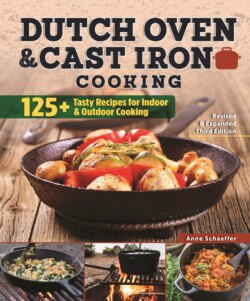Читать книгу Dutch Oven and Cast Iron Cooking, Revised & Expanded Third Edition - Группа авторов - Страница 19
На сайте Литреса книга снята с продажи.
Grill & Campfire
ОглавлениеOn a campfire, burn wood or charcoal briquettes to produce heat (coals), or use a gas grill with a grate or burner. Control the cooking temperature by the number and placement of hot coals, the distance of a grate above the heat and the placement of the cookware. Add fresh hot coals as needed to maintain the cooking temperature until the food is done. Rotate the cookware every 10 to 15 minutes to avoid uneven cooking or burn spots. Cooking on a grate usually requires a little extra time.
Skillets: Place a skillet on a grate directly over hot coals or gas grill heat. For a lower temperature, slide the pan to one side, away from the heat (indirect heat). Use skillets with or without a lid.
Griddles: Place a griddle on a grate directly over hot coals or gas grill heat; move it to the side to reduce cooking temperatures (indirect heat). For griddles to perform well outside, they need even heat.
Pie irons: Place a pie iron directly on hot coals or on a grate. For a lower temperature, move it to the side or hold it above coals. Flip the iron for even cooking.
Dutch ovens: Place a Dutch oven directly on hot coals or on a grate, or hang it over a fire. To rotate, lift the pot and turn it ¼ to ⅓ turn in one direction before setting it back on the heat. (Setting the legs back into vacated spaces between coals makes this easy.) Turn the lid ¼ to ⅓ turn in the opposite direction.
The number of coals you use and the way you place them will determine the cooking temperature inside a Dutch oven. Experiment with your own gear to find the methods that work best for you. The pointers on pages 33–35 will help you get started, but remember to monitor cooking and adjust the heat up or down as needed.
Pay special attention to the food when cooking over an open fire to avoid uneven cooking and burn spots.
